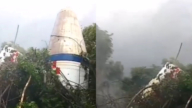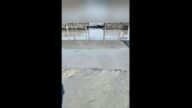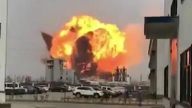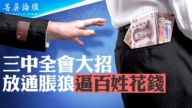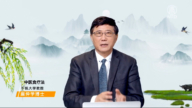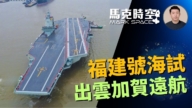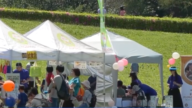【新唐人2014年01月03日讯】随着近年来“镉大米”、“重金属蔬菜”等事件的相继曝光,大陆的土壤污染问题逐渐引发社会关注。虽然中共当局对外声称,已经对中国各地的土壤进行了大范围检测,却一直以“国家秘密”为由拒绝公布调查结果,令外界更加怀疑和猜测大陆的土壤污染问题,恐怕已经到了极为严重的程度。
周一(2013年12月30日),在国务院新闻办公室举办的新闻发布会上,国土资源部副部长王世元对外公布了“第二次全国土地调查”的部分数据。虽然这是中共当局自1996年以来政府首次公布土地状况,却依然没有公开中国土壤污染的详细状况,只是在回答记者提问时提到:中国的中度、重度污染耕地已经达到约5千万亩。
据大陆媒体报导,国土资源部官员并没有就“5千万亩”这一数据作出详细说明,也没有提供可比较数据,只是简单介绍,中国土壤污染,主要集中在长江三角、珠江三角洲地带,以及东北老工业基地等工业密集区和采矿区。并表示,重金属污染是造成土壤污染的主要因素。
根据美国《华尔街日报》计算,5千万亩的污染面积,相当于2012年中国耕地总面积的2.5%左右。也就是说,中国2.5%的土地,因受到了重金属和其他污染物的重度污染,而无法耕种。而这个比例还不包括普通程度的土壤污染。
中国环境保护部在2013年发表的《土壤污染与人体健康》一书中指出,中国受重金属污染的耕地面积已达2000万公顷,占全国总耕地面积的六分之一,每年有1300万吨粮食和农作物会被重金属污染。
在众多重金属污染中,“镉污染”被认为是危害最大的,尤其是在有“中国粮仓”之称的湖南省,“镉污染”现象极为严重。据《纽约时报》引用一家市场调研公司的资料显示,2012年湖南出产了1700万吨的镉大米,占全国总量的16%。而这些镉大米都进入了中国百姓的餐桌上。
台湾中兴大学土壤环境科学系副教授、英国“牛津大学”植物科学系博士 黄裕铭:“而且因为镉在低浓度,对人就有毒害,而且更严重,就是说,它植物是比较容易吸收的。 (吃了镉大米)就是人的神经会痛嘛,它还会引起肾衰竭啊、骨质疏松等等这些都会。现在食品的安全这个问题,大陆真的不能不面对。”
专家分析,造成大陆土壤污染的主要原因是废水排放、工业固体废物堆积,以及农药、化肥的过度施用。
黄裕铭:“工业废水一定要严格管制啊!就是因为水污染才会造成土污染的,那个水如果不控制好,那个污染就会一直扩散﹔有些工厂很恶劣,就是说它们工厂的废弃物都乱丢,也会造成污染的散播﹔有一些肥料也会!大陆的农药要管制啊,像台湾都已经禁药的,大陆都还在用。”
此外,国土资源部在报告中还宣称,受污染、城镇化等因素的影响,近年来中国耕地面积持续减少,仅2006年到2009年的三年中,中国的耕地面积就减少了0.2%。目前,中国人均耕地只有1.52亩,还不到世界人均耕地面积的一半。报告数据显示,13年来,全国城镇用地增加4178万亩,占用大多优质耕地。
黄裕铭:“建设最好不要去用到良田,因为大陆现在建设开发超可怕的!我要讲的就是说,像很多大陆一开发城市就是‘哇!’非常大、非常大,那这个就可以想像到占用很多地。”
国土资源部表示,当局以后每年将拿出几百个亿,启动重金属污染耕地修复,并进一步退耕还林、还草。但民众认为,各地政府为了所谓GDP增长,一面纵容企业对环境造成的污染,一面侵占大量良田和耕地进行土地开发,牟取暴利,才会造成大量耕地污染和流失。当局不从根本上解决这些问题,反而要拿纳税人的钱,高价修复已经严重污染的土地,真实意图昭然若揭。
采访编辑/张天宇 后制/钟元
China suffers land loss from pollution
Soil pollution is a prevalent issue in China, and high levels of
heavy metals have been detected in rice and vegetables.
China’s land survey results have long been a “state secret",
and many people are suspicious that soil contamination levels
in China may be more severe than recently reported.
China’s Deputy Minister of Land and Resources revealed the
national land survey results during Monday’s State Council
press conference, a first since 1996.
The official said some 50 million mu (8.2 million acres) of
soil is medium to heavily polluted and unfit for farming,
but he left out many further details.
Mainland Chinese media reported that the official didn’t
elaborate on the 50 million mu of polluted soil and
provided no comparable figure, but indicated heavy metals as
the main pollutants in industrial and mining areas in
the Yangtze River Delta, Pearl River Delta,
and the old industrial bases in northeastern China.
Wall Street Journal says that the pollution figure
equals about 2.5% of China’s total arable land in 2012.
Meaning heavy pollution has made 2.5%
of China’s arable land unfit for farming.
This figure does not include mildly contaminated soil
that could also harm crops.
A book published by China’s Ministry of Environmental
Protection in 2013 titled, Soil Pollution and Human Health,
says 20 million hectares of arable land is heavy-metal polluted,
accounting for one sixth of the total cultivated area.
That equates to 13 million tons of
heavy metal contaminated foods and crops per year.
Scholars say soil pollution is especially acute
in Hunan Province, which is known as China’s rice bowl.
Among the heavy metals,
cadmium is considered to be the most harmful.
The New York Times reports that according to one
market research company, Hunan produced 17 million tons
of rice in 2012, “16 percent of the national total".
Huang Yuming, associate environmental sciences professor
at Taiwan National Chung Hsing University:
“Cadmium is toxic even at low levels and
poses greater risk of toxicity, as crops absorb it more easily.
The tainted rice will lead to nerve pain, kidney failure, and
osteoporosis. China cannot avoid the issue of food safety."
Experts say that soil pollution in China is mainly caused by
wastewater discharges, accumulated industrial solid waste,
pesticides, and excessive use of fertilizers.
Huang Yuming: “Industrial wastewater must be strictly
controlled, because polluted water leads to soil pollution
and the further spread of pollutants.
Some factories have no ethics. Their randomly disposed
industrial waste spreads the pollutants.
Fertilizers are also one of targets that need to be controlled.
Taiwan has banned some of the fertilizers
but the Chinese mainlanders continue using them."
The Land bureau also said that the land problem stems from
pollution and industrialization.
The total arable land figure went down
about 0.2% from 2006 to 2009.
China’s stock of arable land has fallen to 1.52 mu per capita
and is less than half the world average per capita.
In the past 13 years, 41.78 million mu (6.9 million acres)
of high-quality arable land have been urbanized.
Huang Yuming: “The arable land should be avoided in
urbanization.
The urbanization of China’s farm land has been scary.
They occupy huge areas whenever a new city is developed.
You can imagine how much farm land has been lost."
The Land Ministry says an initiative to treat tainted soil and
convert degraded farm lands into forest and grass lands
with annual budget of tens of billions will be launched.
But there are criticisms that the massive soil contamination
and arable land loss is caused by local governments condoning
industry activity on pollution issues and making profits
through arable land grabs in the name of raising GDP.
Without correcting these problems, yet engaging in
the expensive recovery of tainted soil,
the true intentions of the authorities are abundantly clear.
Interview & Edit/ZhangTianyu Post-Production/ZhongYuan


